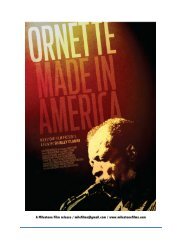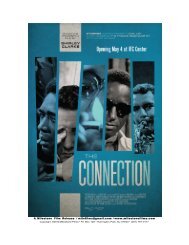ORNETTE Press Kit.8.7.2012 - Shirley Clarke
ORNETTE Press Kit.8.7.2012 - Shirley Clarke
ORNETTE Press Kit.8.7.2012 - Shirley Clarke
Create successful ePaper yourself
Turn your PDF publications into a flip-book with our unique Google optimized e-Paper software.
video editing, she could, with the touch of a finger, instantaneously translate the lightening-‐<br />
fast flow of emotion into editing cuts.<br />
In her video work, Tongues and Savage/Love (1982-‐3), the actor Joe Chaikin’s<br />
discontinuous expression as a result of his stroke, is taken into a dimension of hyperreality.<br />
In these 2 masterpieces of Chaikin, author/narrator Sam Shepard, and <strong>Clarke</strong>’s directorial<br />
choreography, create a whirlwind of morphed images, sound, alternate personalities,<br />
stream of consciousness and tempo, which overcome the viewer in an ecstasy of virtuosity.<br />
Her Last Film<br />
I produced and collaborated with <strong>Clarke</strong> on her last film, Ornette: Made in America (1985).<br />
She always wanted to do a film on the scale of the musicals her mentor, Hanya Holm<br />
choreographed-‐ My Fair Lady, Camelot, and Kiss Me Kate. We did a full length feature, as<br />
dear <strong>Shirley</strong> would say, “Just like a real movie” -‐ rolling credits, with a ‘real film’s aspect<br />
ratio’, widescreen. But this film was hardly a Camelot; it was the life of legendary avant<br />
garde musician Ornette Coleman. <strong>Clarke</strong> was liberated and uncompromising as always,<br />
and, as she had mastered her directorial and editing techniques and style, she achieved<br />
‘free dance’ in film. We had a certain rapport because both of us had originally trained in<br />
dance, I with Anna Halprin who had also trained Yvonne Rainer and influenced many<br />
others, including The Living Theater’s Paradise Now. During the months of editing, we<br />
would often visit The Joyce dance theatre around the corner, to see performances. At<br />
dinner before, she would always order salads, occasionally some chicken, and a glass of<br />
white wine. “A dancer has to keep her figure,” she’d laugh. Her dancer’s body is apparent<br />
from photographs of her directing. She had an inherent grace and ease with her body.<br />
Many of the characters of her life up to that time passed through our editing rooms in the<br />
Chelsea Hotel. In this film, the various strands in her creative came together: the avant<br />
garde, jazz, classical music, race and gender issues, film, video, radical and precise intellect,<br />
generational transmission, sexuality, heightened consciousness, dance as inspiration… She<br />
laid down the music track first, the performance of Coleman’s symphony, Skies of America,<br />
so the music became the ‘plot’. Flashbacks, interviews and oneiric sequences show<br />
Coleman is at the same time performing in the Texas of his youth, New York of his present,<br />
and throughout his professional and personal life. <strong>Clarke</strong> worked with temporal and spatial<br />
discontinuities, seeking the ability to ‘be present’ in different places at the same time. We<br />
were both focused on recreating the inner life of a creative avant garde artist. Ornette<br />
Coleman lives in polyrhythms, thinks in a lyrical mode. In this work <strong>Clarke</strong> achieved her<br />
most intimate aim, portraying the inner life of a pioneering artist.<br />
Her own process was to create a cognitive map based on a motor space/time: a kinesphere.<br />
To connect with a filming or editing, she would sense the musical score, or the musicality of<br />
the scene/dialogue. To test just-‐completed rough edits, we would sometimes stand and<br />
move to the shape and tempo of the images.<br />
32




